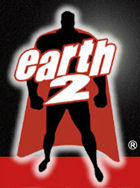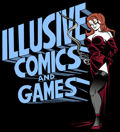|
|
|
Jason
Schachat has a crush
on Ellen Dolan.
|
Jason
Schachat's Occasional Breakdown
12/05/06 If
you buy just one comic this week, make it Batman/The
Spirit #1. This joyous oneshot merges the
delightful styles of Darwyn Cooke and the late grandmaster
Will Eisner to answer the question no one ever asked: How
did The Spirit meet Batman?
Meshing together
the two universes with little concern for continuity (Catwoman
is a villain but wearing her current costume, Joker is flanked
by Harley Quinn, the world is locked in the art deco fantasia
of the 40s), this may not be a story you’ll ever expect
a follow-up to, but oh, how you’ll crave it.
The plotline
is from a simpler time: all the villains from Central City
and Gotham City have flown the coop and converge on a police
convention in Hawaii. Spirit has to get Dolan away from
the seductive Poison Ivy, Batman has to save Gordon from
P'Gell, Robin says things like “Holy Torpedo!”,
and the Joker gets to be the clown prince of crime rather
than a bloodthirsty psychopath.
Sure,
you can call it nostalgic, but we need a dose of it every
once and a while. As Cooke proved with DC:
The New Frontier, nostalgic doesn’t have
to mean hackneyed or boring. There’s no harm in bypassing
a few retcons to recapture that sense of fun that used to
define superhero comics.
|
|
Ten
beers later -- same expressions.
|
But,
when you have a team like Jeph Loeb and Darwyn Cooke handling
it, the overly-expository 10-pager of days gone by fleshes
out into the gorgeous 40-page story they give us here. It’s
a great read for fanboys, kids, and newbies alike. If you’re
looking for a no-commitment all-ages comic book stocking
stuffer, Batman/The Spirit is the best candidate
of the season.
Crossing
Midnight #1 is a book that reminds us why
we liked writer Mike Carey in the first place: he started
out at Vertigo. Most of Carey’s Marvel work feels
overly restrained or derivative, but, in the hands of editor
Karen Berger, he starts a new story that immediately feels
unique.
Much of this
probably comes from where and when the story starts: Nagasaki
after the atom bomb hit. But that doesn’t awaken ancient
demons or imbue the survivors with powers. Instead, it re-awakens
religious beliefs in a survivor. She begins to worship an
old shrine given to her by her mother.
When
her own son is about to have a child, she insists the young
couple make an offering to the Kami, the spirits of the
shrine. Not knowing any other way to appease the old woman,
they say the words without thinking and find themselves
parents of twins – rather than the single child they’d
expected.
Still, nothing
seems amiss. It’s only as the years go by that the
children begin to sense the supernatural goings on that
surround them and demand tribute...
Carey does a
nice job pulling snippets from Japanese culture without
making another wannabe manga ripoff. Of course, that may
end up hurting sales more than anything else. Jim Fern’s
pencils are quite nice (if not entirely consistent), but
don’t resemble any of the familiar anime and manga
styles. Is that a crime? No, but you can’t deny that
manga sell damn well.
I think the other
thing that makes me worry for the future of this book is
the amount of setup Carey gives us. Nearly the entire first
issue is told as a flashback, building up to the confrontation
sure to come next month. While it makes for a good read,
we really can’t tell if the story’s got legs.
For
the most part, I’d say Crossing Midnight
is worth a look. It has the same flavor that made Lucifer
a hit. My only worry is that the aftertaste won’t
be so sweet.
|
|
Half-midget,
half-gorilla, all-Captain!
|
It’s
pretty sad to see Jeph Loeb putting out Onslaught
Reborn #1 the same week as Batman/The
Spirit. If you ever doubted the importance of an artist’s
contributions to storytelling, look no further than that
comparison.
Where
Darwyn Cooke is truly inspired and makes his relatively
simple story sing, Rob Liefeld (AKA All-But-The Writing,
Colors, Letters, Production– basically he’s
just a damn penciller who inks now and then) takes a whole
issue to say that Onslaught is back (turns out he was that
cloud floating around the Earth after Wanda wished away
all those mutants) and still wants Franklin Richards.
Liefeld
spends about eighteen pages demonstrating how every character
he draws will dislocate their jaw whenever they want to
say something. Interestingly, he also somehow squeezes out
two pages where we get a closer look at Franklin’s
face and see much more nuance then we’d ever expect.
I’m not sure if someone actually had the guts to tell
Liefeld to re-do panels, but there’s something different
here. And it works.
If only more
than 1% of the comic were drawn that way.
The
rest is the usual shallow power fantasy where we need some
excuse, ANY EXCUSE to have some characters beat the snot
out of each other for two dozen pages. There’s no
plot, no development and no obstacles. We begin and end
with Onslaught hunting down Franklin Richards.
My advice is
to save your money for more worthy aftermath stories that
aren’t coming a decade after they’ve lost their
relevance.
Where
common sense would dictate that Ultimate Power
#2 should explain how and why Squadron Supreme
has crossed over into the Ultimate Universe, all you really
get is nineteen pages of brawling and one page of justification.
I almost
hesitate to say Bendis is really involved with this book,
since the only traces of his style are certain go-to lines
of dialogue and onomatopoeias. It’s really just a
collection of Greg Land artwork. That’s both where
it succeeds and fails.
|
|
Somewhere
in this cover everyone can find
an image worth a little "me" time...
|
No one
will dispute that Greg Land is a talented artist. He’s
achieved what so many consider to be the peak of the form:
realistic representation of the human form. Sure, his work
is painfully photo-referenced and clearly borrows from images
in other media, but it’s pretty. That’s what
sells.
However,
when you put it all together like this, the feeling is definitely
more of a collection than a flowing story. His big compositions
feel static and bring any fight scene to a screeching halt.
When the Blur speeds off to keep Hyperion from falling onto
a crowd of innocent bystanders, it just doesn’t feel
FAST. We’re confused by his mis-steps that find him
in Indiana and Liberty Isle. The transitions are just too
haphazard.
As I
said of Liefeld earlier, there are just too many panels
where characters have their mouths hanging open like humpback
whales hoping to scoop up schools of krill. If only three
people in a panel are talking, why can we count the teeth
on all of them?
It makes for
a nice bunch of poses and explosions, but there’s
no flow and no meaning to it. Too many of the views are
head-on, the feeling of movement is lacking, and readers
will have a hard time following characters through the fight.
Sure, that won’t
matter to people who just want some “pretty”
art slapped together to make a comic book, but anyone hoping
for a story or just a good fight scene should look elsewhere.
|









